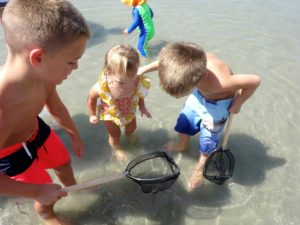An Oceanfront Education

To view the photo-rich magazine version, click here.
Originally appears in the Fall 2018 issue.
A WOMAN STOOPS OVER and peers intently at the waves lapping against the sand on the Sanibel Island shoreline as she looks for ocean treasures of spiraled Florida conchs and swirled lightning whelks. Moments later, a clap of thunder draws her attention toward the sea. As she stares into the water, a huge mass emerges from the ocean directly in front of her. It slowly shuffles out of the water and onto the beach. The woman grabs her bag of shells and frantically waves to her daughter, who gets up from her towel to watch the algae-covered mass stop and begin to shift the sand out from underneath itself. They are witnessing a loggerhead sea turtle uncharacteristically laying eggs during the day — probably to avoid an oncoming storm.
Like most loggerheads, this four-foot-long turtle has a streamlined shell with barnacles scattered across its brown surface. Her nest is one of five that she will dig sequentially during the summer nesting season, each producing around 110 hatchlings. This turtle most likely migrated hundreds of miles to dig her nest, and she will take a well-deserved two-year vacation before nesting again.
The mother and daughter excitedly call the Sanibel turtle nesting hotline to report the location of the new nest. The volunteers arrive within the hour and begin to monitor the unusual daytime nesting. When the loggerhead sea turtle is finally done burying her eggs, she ponderously shuffles back into the ocean, leaving tracks as deep as those of a small tractor. The volunteers immediately place a screen around the nest to protect the eggs from predators and unwary beachgoers. The screen has wide enough gaps through which hatchlings can emerge on their way back to the sea two months later. The lifespan of a loggerhead sea turtle can last as long as 90 years — so long that a grandmother sea turtle can nest at the same time as her granddaughters, even though it takes 30 years for a loggerhead to become reproductively active.
This content is restricted to subscribers only.
If you are not yet a subscriber, please consider taking out a subscription here.
If you are an existing subscriber, kindly log in or contact us at info@greenteacher.com for more information.










